Many of the 22 sections of this book and its illustrations cover the Roman army’s use of artillery in Britain: Caesar cleared the Britons off the beach in 55 BC with slingshot, arrows and catapults, and Vespasian used bolt-shooting catapults to assault the Iron Age hillforts of Maiden Castle and Hod Hill in Dorset during the Roman Invasion of AD 43.

Section 13 on artillery on Britain’s northern frontier offers an interpretation of the Roman camps straddling Burnswark Hill in Dumfriesshire, and the artillery missiles found there.
The archaeological evidence for reconstructing the bolt-shooter is reviewed, including the rare catapult frame parts from Carlisle (below centre) and the remarkable 1999 discovery (below left) of the almost complete catapult frame at Xanten-Wardt in Germany.

The accuracy, range and effects of bolt-shooting catapults, the types and sizes of bolt, and the power source of animal sinew rope-springs are discussed.

The author’s reconstruction of the later arch strut bolt-shooter (centre and right hand photos above) is the sequel to Dr Eric Marsden’s identification of the Cheiroballistra (‘Hand-catapult’) manuscript as a description of this new design of catapult with a metal frame and an arch strut identical to that of the catapults on Trajan’s Column in Rome (above left) which illustrates Emperor Trajan’s campaigns of AD 101-2. This is the type of catapult still recorded in action in a document of AD 1060.
Len Morgan and the author have reconstructed the Roman legions’ stone-throwing ballista (photos below), based on the first fully-revised edition of the Latin text of Vitruvius since the previous unsatisfactory version of 1917.
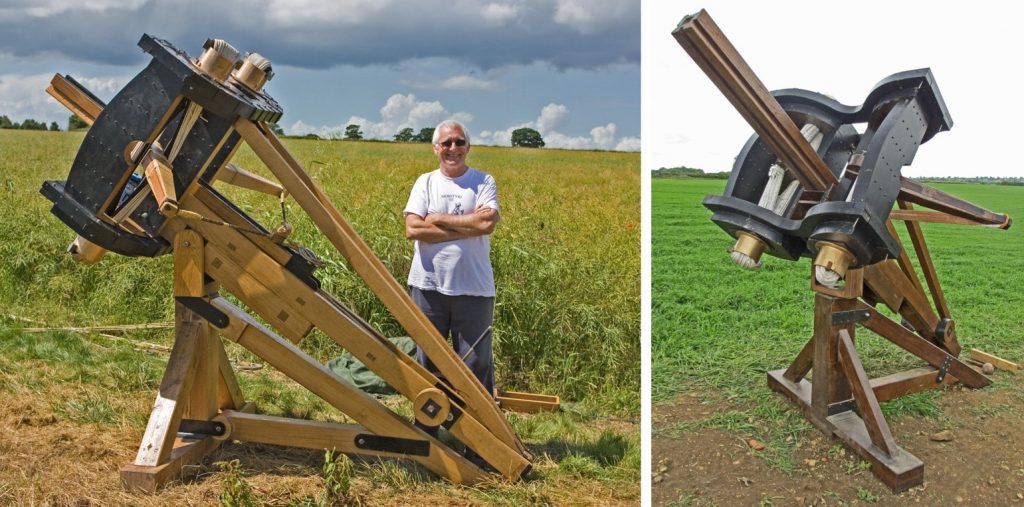
Discussions of the range and effects of the stone missiles and the use of artillery in the siege of Masada in Israel are followed by an account of the Roman defence of the Nile fortress of Qasr Ibrim (below), with its unique carbon ink inscriptions by five centurions on 38 of the hundreds of catapult balls.

Read the full Qasr Ibrim report here
The stone-thrower found at Hatra in Iraq is described in the context of the theory that some catapults had inward-swinging arms. There are sections on the Elenovo crank handle; the one-arm onager catapult; the Roman achievement; future search and research; sources and references to artillery; museums and sites; websites and TV programmes.
Graeco-Roman catapults, which used the energy stored in tensioned and twisted rope-springs, were the most powerful missile launchers of their time in the western world. So the importance of establishing the exact appearance, design and performance of these machines cannot be overstated. Invented in about 350 BC, these sophisticated machines were used by Greeks, Carthaginians, Romans and all the countries around the Mediteranean and in the Near East. They are still recorded in use 14 centuries later by Byzantine armies. No other weapon launching heavy missiles has dominated western warfare for so long. The three main sources of evidence for this are the Greek and Latin technical texts, some scattered finds of actual catapult parts, and representations of catapults on stone relief sculptures.
The three types of catapults most used by the Roman legions are:
1. The bolt-shooter (catapulta, the smaller size is often called scorpio). It is described with the measurements of parts by the famous Roman architect-engineer Vitruvius, appointed in charge of catapult construction and repair by Emperor Augustus. The earliest and best copy of Vitruvius’ Latin text was written by the same monks who produced the Lindisfarne Gospels. This is now backed up by the 1999 discovery at Xanten-Wardt in Germany of the virtually complete front frame of a scorpion, where even the internal wood frame has survived.
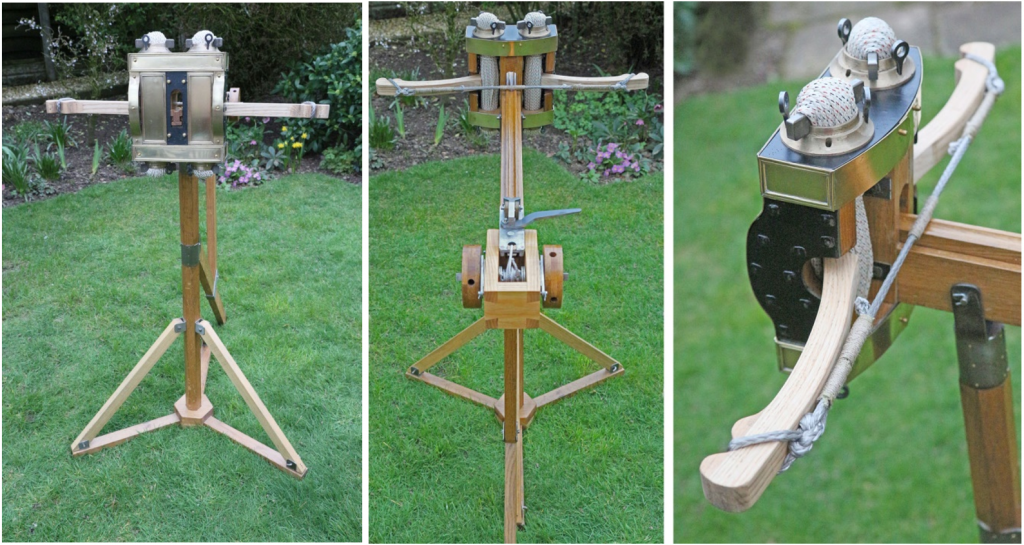
The Xanten-Wardt frame reconstructed with millimetre accuracy by Tom Feeley, Len Morgan and Alan Wilkins, with the arms, stock, windlass and stand restored from measurements in the text of Vitruvius.
2. The manuballista ‘hand catapult’ (Greek cheiroballistra), the Roman army’s complete redesign of the wood frame bolt-shooter, with a metal front frame whose top strut had a semi-circular arch. It is usually referred to today as the arch strut catapult. The earliest evidence for its use is on five scenes on the spiral reliefs of Trajan’s Column in Rome which commemorate Emperor Trajan’s campaign against the Dacians of AD 101-2. It was one of Dr Eric Marsden’s finest achievements to prove that the illustrated manuscript entitled Heron’s Construction and Dimensions of the Cheiroballistra (‘Hand catapult’) was a description of this machine.

(left) The first two of the five pages of the Cheiroballistra manuscript; page 2 includes the drawing of the strut with the semi-circular arch. (right) Dr Eric Marsden made a very fine reconstruction just from the description and dimensions in the manuscript and the depictions of the catapults on Trajan’s Column. Tragically he died in 1975 before he could work out a fresh reconstruction making use of the vital evidence of actual parts from this type of catapult which had been published the previous year. His friend Alan Wilkins, the editor of this website, has incorporated the evidence of these parts in a new reconstruction. There are two versions of this, the earliest, built by Len Morgan and Alan Wilkins, will be in their display of four catapults at Tullie House Museum, Carlisle (due to open in summer 2018). The second, slightly revised version was built by Tom Feeley in 2012 and is already on permanent display at Carvoran Roman Army Museum on Hadrian’s Wall.
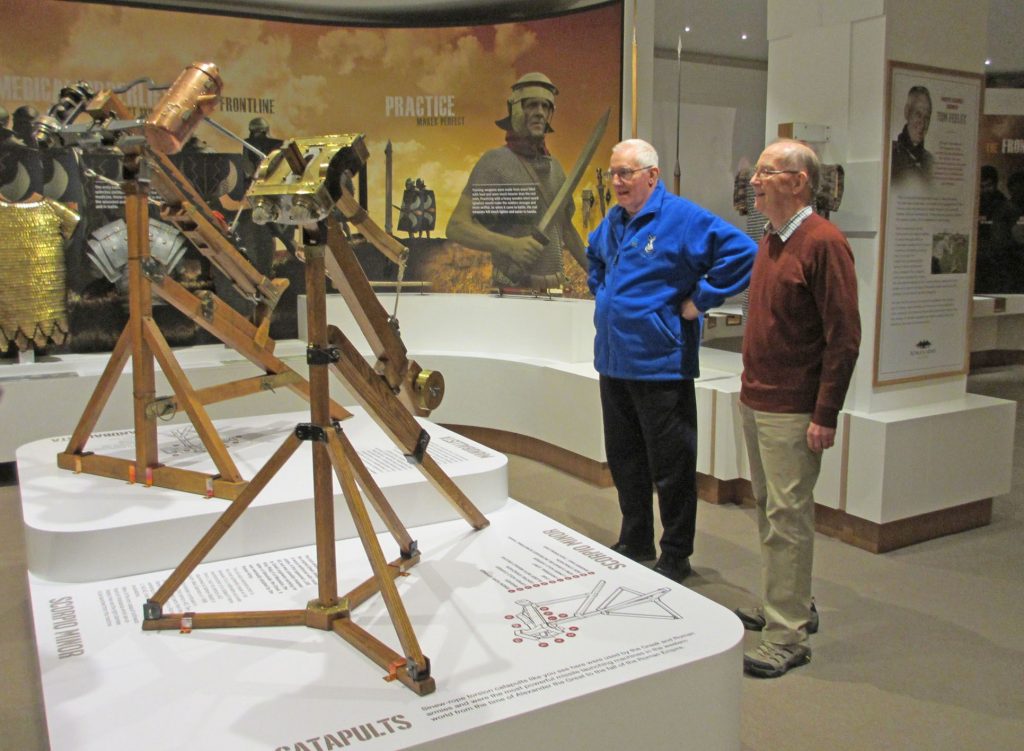

(above) Len Morgan and Alan Wilkins admiring Tom Feeley’s superb reconstructions of the two types of Roman bolt-shooters, a scorpion and a manuballista, in the exciting display at Carvoran Roman Army Museum on Hadrian’s Wall. (left) A very large version of the arch strut, from Orşova on the Danube. (centre) the 1995 Wilkins-Morgan version, about to launch a replica bolt. (right) Tom Feeley’s version ready to shoot.

The greatest improvement and advantage of this totally different design of frame is proved by the left hand photo, which shows the artilleryman’s view as he aimed up the missile groove. The old design’s large solid wood frame tended to block the artilleryman’s view of an enemy who was closing in on him. He now had an excellent ‘wide-screen’ view of the target area, allowing him to follow an approaching enemy however much the latter swerved, and to delay the release of the bolt until a hit was certain and the bolt would penetrate with maximum force. Eric Marsden made the convincing suggestion that the semi-circular arch in the upper strut could have been used to frame the approaching enemy target and therefore improve accuracy of aim.
The right hand photo is the editor’s replica of the bolt from Tower 19 at Dura-Europos, the only Roman catapult bolt to survive complete with its wooden shaft. The new design’s open frame allowed the standard iron head to be mounted onto a stockier, expanding shaft with wooden flights. One of the advantages of this evil-looking missile over the older dowel-shafted bolts is that its shaft had wounding properties of its own: its expanding profile would create a constantly enlarging entry wound, ripping muscles and crippling, if not killing men and horses. If it penetrated up to the flights, being of wood these would open the wound further and act like barbs, making removal of the missile extremely difficult and painful. Our tests confirm that this bolt is usually straight and stable in flight, confirmed by American wind tunnel tests which have also proved its low ratio of drag to mass, and the fact that its tail, tapered to fit between the claws of the trigger, reduces the turbulence at the rear.
3. The ballista stone-thrower. This was another rope spring powered Greek design, which was also adopted and eventually improved by the Roman army. The catapult bolt in the photo above weighs 155 gm, but the smallest size of ballista had to be capable of launching a stone ball weighing around 650 gm and the largest catapult ball in regular use by the Roman army weighed 26.2 kg. It is hardly surprising that the framework had to be immensely strong to be able to project the weights of stone shot. Instead of the scorpion bolt-shooter’s wooden all-in-one spring-frame, each rope spring was given a separate, hefty spring-frame of strong plated timber. The two spring frames were clamped together by a framework of top and bottom crossbeams and crossbars, and were set at angle to allow an increased arc for the arms, and so increased spring power.
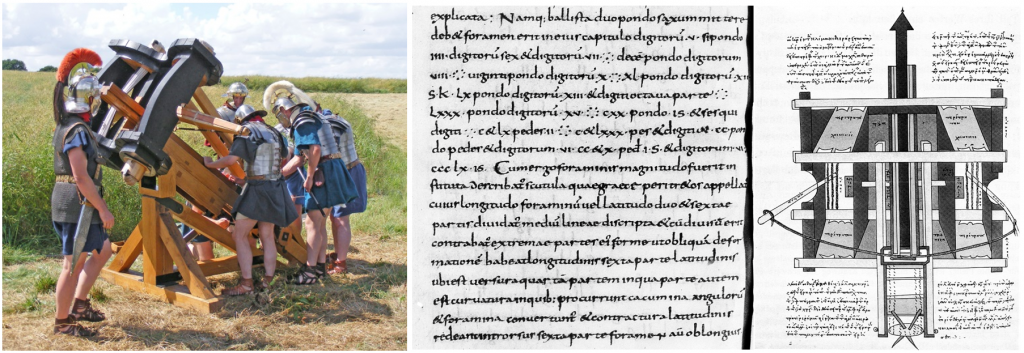
No parts from this machine have been identified to date. Therefore it has to be reconstructed from the Latin text of Vitruvius, the description of an earlier version of the same machine by engineer Philon of Byzantium, and some valuable diagrams and advice from the famous engineer Heron of Alexandria. Because Vitruvius was one of four officials appointed by Emperor Augustus to supervise manufacturing and repairing the Roman army’s catapults, his description presumably represents the official version of the machine in use in the early Roman Empire. Unfortunately the drawings that originally accompanied Philon and Vitruvius’ text have been lost.
The left hand photo above shows the suggested reconstruction by Alan Wilkins of the ballista, brilliantly realised at full-size by Len Morgan. A crew of some 4 to 5 modern ‘legionaries’ is required to assemble the catapult and its stand. This is the smallest size of ballista on Vitruvius’ list, designed to launch a 2 librae (0.65kg) weight of stone shot. The centre illustration is from the copy of Vitruvius written by the monks on the island of Lindisfarne; it is the beginning of Vitruvius’ description of the ballista (the word can be read in the top line). On the right is part of the text with a drawing of the ballista from the Greek manuscript of Heron of Alexandria’s Belopoiika (‘Artillery Construction’).
The other known type of catapult was the One-arm stone-thrower, also known as the Onager (‘Wild ass’). It was designed to launch very heavy stones, and although it is only mentioned very occasionally by Greek and Latin writers, it may have been used in sieges from the Hellenistic period onwards. It is described by Ammianus Marcellinus, the fourth century historian and army officer, who operated these stone-throwers in Emperor Julian’s campaign against the Persians (AD 359 – 363). It had a single vertical wooden arm inserted into a single skein of rope; when released the arm struck a huge buffer of ‘goat’s hair cloth padded with fine chaff’. A sling holding the stone hung from hooks on the top of the arm. Unfortunately Ammianus does not give a full description of the framework; there are several different modern reconstructions.
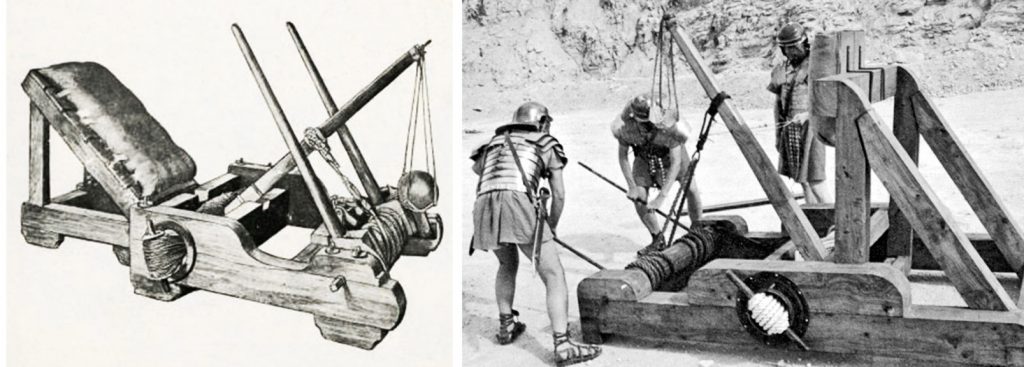
(left) General de Reffye’s impressive interpretation of the onager from Ammianus’ description. (right) A version built by the Ermine Street Guard, based on the ‘railway buffer’ reconstruction by Sir Ralph Payne-Gallwey.
What did they look like and how did they work? The checkered history of catapult research
Unfortunately research and attempts to understand these machines have suffered disastrous time-wasting setbacks. It was Napoleon’s nephew Emperor Napoleon the Third who instigated the first attempts to discover what these machines looked like and how they worked. In 1840, using the Latin descriptions by the Roman catapult engineer Vitruvius, his generals Reffye and Dufour published their full-size versions of the stone-throwing ballista, and the bolt-shooting catapulta. By 1853 German experts Kӧchly and Rüstow had made valuable initial progress in attempting to understand the very difficult Greek technical texts, of which a splendid edition was produces in 1867 by the Alsace scholar Carl Wescher.
After that there was slow progress and two major setbacks: first, in 1906 the extremely important illustrated Greek manuscript clearly entitled Heron’s Construction and Dimensions of the Cheiroballistra (‘Hand catapult’) was, quite unbelievably, dismissed by Professor Rudolf Schneider as not a description of a catapult. As a result this machine was ignored by Erwin Schramm, the great experimental archaeologist, who from 1904 to 1928 had produced reconstructions of all the other recorded types of Greek and Roman catapults. It was Dr Eric Marsden who in 1971 put an end to this manuscript’s shameful 65 years of neglect by identifying it as a description of the Roman army’s revised design of bolt-shooting catapult, with a metal frame and an arch strut identical to that of the catapults shown on Trajan’s Column in Rome. See photos above. Marsden also spotted the other critical setback, in that Schramm’s 1917 reconstruction of the stone-throwing ballista, followed by most modern reconstructions, is based on a rather reckless interpretation of Vitruvius’ Latin text. Schramm without explanation changed 20 of the 49 numerals giving the sizes of the machine’s parts to something quite different from those in the surviving manuscripts of Vitruvius.
Marsden’s scholarly two–volume Greek and Roman Artillery, published in 1969 and 1971 and reprinted in 1999, raised the quality of artillery research to a much higher level. These books, Historical Development and Technical Treatises, are essential reading for anyone interested in this subject. Tragically, Marsden died in 1975 aged 49, before he could interpret and incorporate the actual parts from arch strut catapults found in forts on the Danube frontier and published in 1974. The editor of this website, his friend Alan Wilkins, has tried to maintain the momentum of Marsden’s research, and has just published the results in this new book Roman Imperial Artillery, available from this website (See above).
Where to find out more; a list of important books and articles about Roman artillery. See PDF here.
News of fresh discoveries.
News is just coming in of discoveries of groups of stone catapult balls in the River Rhine which may have been launched from onshore batteries to control illegal river traffic. More on this as soon as I have the full details.
Forum
Comments or requests for information on aspects of Roman artillery are invited and can be emailed to Alan Wilkins at contact@romancatapults.co.uk . He will publish a selection of these.